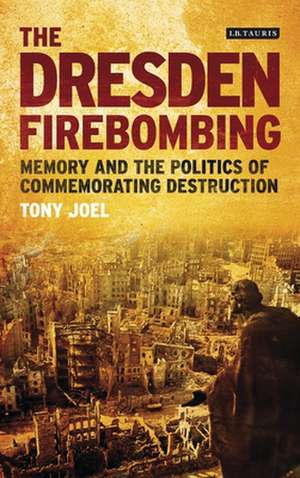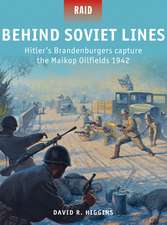The Dresden Firebombing: Memory and the Politics of Commemorating Destruction
Autor Tony Joelen Limba Engleză Paperback – 29 apr 2020
| Toate formatele și edițiile | Preț | Express |
|---|---|---|
| Paperback (1) | 226.24 lei 6-8 săpt. | |
| Bloomsbury Publishing – 29 apr 2020 | 226.24 lei 6-8 săpt. | |
| Hardback (1) | 775.43 lei 3-5 săpt. | |
| Bloomsbury Publishing – 19 ian 2014 | 775.43 lei 3-5 săpt. |
Preț: 226.24 lei
Preț vechi: 289.66 lei
-22% Nou
Puncte Express: 339
Preț estimativ în valută:
43.29€ • 46.29$ • 36.10£
43.29€ • 46.29$ • 36.10£
Carte tipărită la comandă
Livrare economică 17 aprilie-01 mai
Preluare comenzi: 021 569.72.76
Specificații
ISBN-13: 9781350159075
ISBN-10: 1350159077
Pagini: 384
Ilustrații: 17 bw illus
Dimensiuni: 135 x 216 x 25 mm
Greutate: 0.45 kg
Editura: Bloomsbury Publishing
Colecția Bloomsbury Academic
Locul publicării:London, United Kingdom
ISBN-10: 1350159077
Pagini: 384
Ilustrații: 17 bw illus
Dimensiuni: 135 x 216 x 25 mm
Greutate: 0.45 kg
Editura: Bloomsbury Publishing
Colecția Bloomsbury Academic
Locul publicării:London, United Kingdom
Caracteristici
Examines how both the death toll and the motivation for the attack have become fierce historical battlegrounds since the end of the Second World War
Notă biografică
Tony Joel is Associate Professor in History in the School of Humanities and Social Sciences at Deakin University, Australia. A former German Academic Exchange Service (DAAD) scholarship holder, and a founding member of Deakin's Contemporary Histories Research Group, Tony's main research interests include the politics of war memory and commemoration and sports history.
Cuprins
INTRODUCTIONThe Destruction of Dresden and the Shifting Dynamics of German Victimisation DiscourseDresden as paradigm of German victimisation and sacrificeWriting about the Dresden bombing and its aftermathConceptual framework and key termsA mythical tabooVictimisation discourse in divided GermanyBombing and victimisation discourse in reunified GermanyApplication of conceptsCHAPTER 1The Western Allies' Strategic Bombing Offensive and Dresden's Transformation from European Kulturstadt to Germany's OpferstadtBuild-upWatershedEscalationWhy is Dresden special? Or, why Dresden is specialWartime reactionsIssues of interpretation: shaping and reflecting controversyConclusionCHAPTER 2The Fashioning of Dresden's Destruction into a Political Asset: 1946 to the Early 1980sThe Nuremberg interregnumThe 1950sThe 1960sThe 1970s and early 1980sCHAPTER 3Dresden's Last Milestone Gedenktag before the Fall of the Wall: 13 February 1985West German mass-mediation of Dresden as OpferstadtThe party's Gro?kundgebungThe reopening of the SemperoperThe Frauenkirche ruinsConclusionCHAPTER 4Dresden Memory Politics in the Schwebezeit: 1989-90Kohl, the ruins, and "die Einheit der Nation"Church over ruins?Dresden's stateless Gedenktag: 13 February 1990ConclusionCHAPTER 5A British Dimension to Dresden Commemorative Politics: 1992-2000Homage to a hangman, or misunderstood memorialisation?Dresden: the awkward but obligatory interludeBritain responds to the Ruf: the Dresden TrustThe 1995 Gedenktag and a signal of intentThe 2000 Gedenktag and making good on a promiseConclusionCHAPTER 6Dresden as a Memory Battleground: 13 February 2005The Queen and Dresden: revisiting a theme, but not the cityDepicting Dresden as the "Bomben-Holocaust"Renewed focus on longstanding controversiesReconciliation remains a central plankMaking a statement in absentiaMixed messages and the struggle over commemorationConclusionCONCLUSIONMemory Work-in-Progress: Remembering the Past, Reflecting on the Present and FutureNOTESBIBLIOGRAPHY











